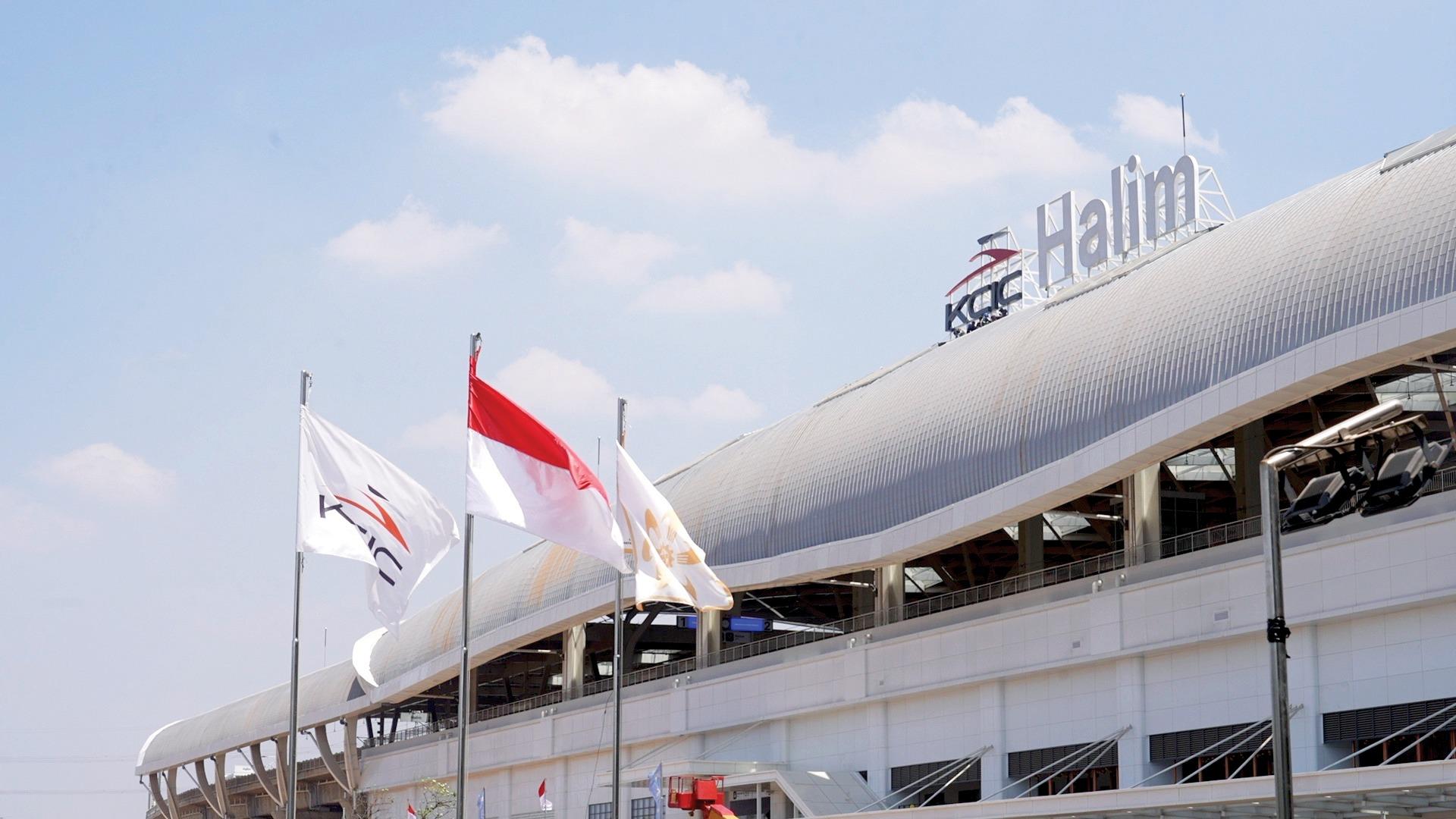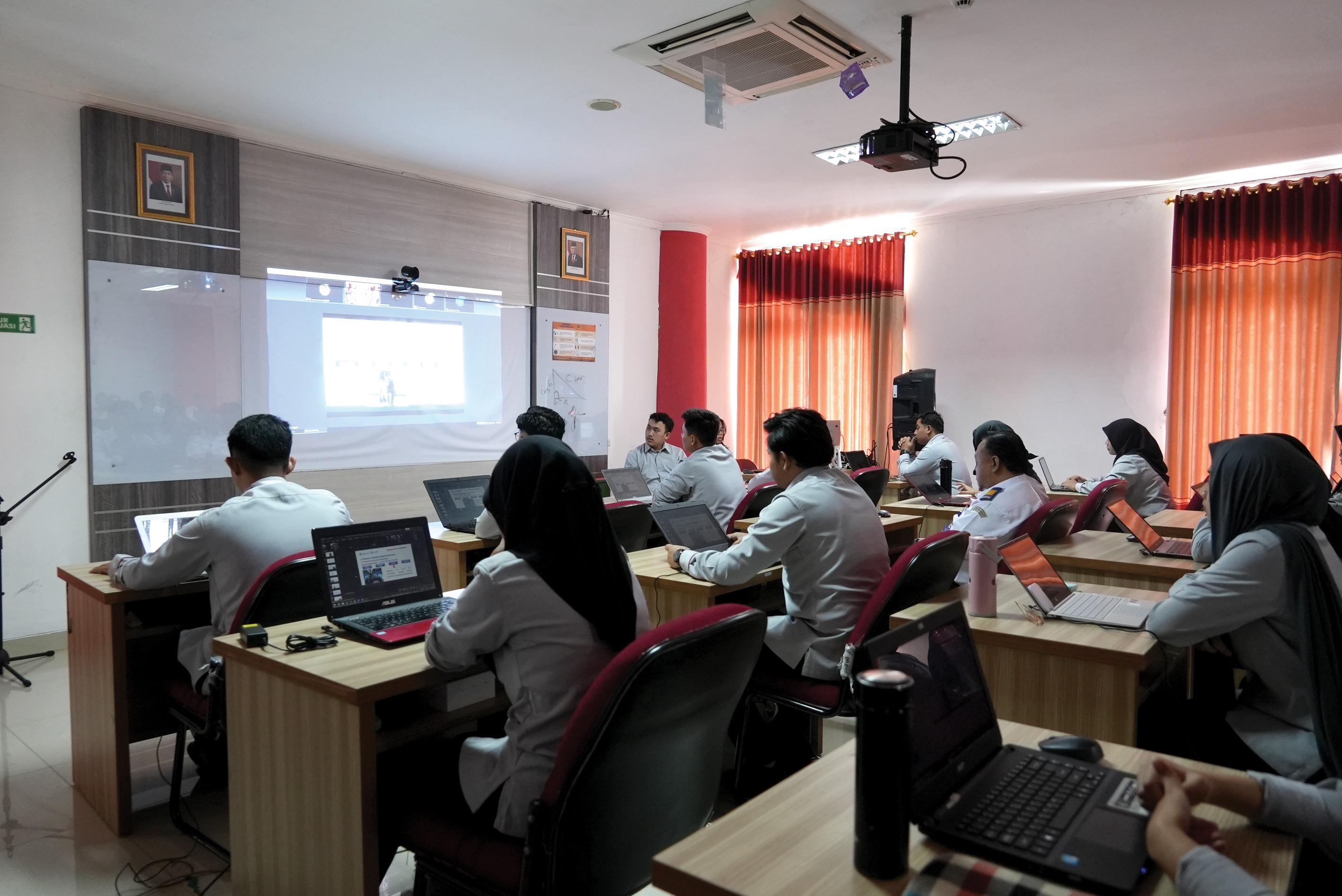The Jakarta-Bandung High-Speed Railway an iconic example of fruitful partnerships under China’s Belt and Road Initiative
 (LI MIN / CHINA DAILY)
(LI MIN / CHINA DAILY)
At the Bandung high-speed rail garage in Indonesia, driver Ali Mustofa was trying to start the bullet train simulator for the first time.
He entered the train number and his driver ID on the screen and followed the instructions of his Chinese teacher, Mu Zhen.
“Keeping your fingers upright can help to avoid touching things unintentionally,” Mu said.
Mustofa then pushed the handle of the simulated bullet train. At this point, the scenery displayed on the large screen in front of the driver began to recede as the simulated train slowly started. Mustofa kept pushing the handle, setting the speed.
“45 kilometers per hour!”
“80 kilometers per hour!”
“150 kilometers per hour!” Mu read out the speed, marking the acceleration of the train.
“That’s fast!” Mustofa exclaimed when the simulated train accelerated to its highest speed of 350 km/h.
“You may feel dizzy for the first time, but don’t worry, you’ll get used to it,” Mu said with a laugh.
 The Halim station of Jakarta Bandung High-Speed Railway, in Jakarta, Indonesia. (PHOTO PROVIDED TO CHINA DAILY)
The Halim station of Jakarta Bandung High-Speed Railway, in Jakarta, Indonesia. (PHOTO PROVIDED TO CHINA DAILY)
The bullet train simulator that Mustofa was practicing on was built by China, reproducing the high-speed rail driving experience on a 1:1 scale. It is being used to train the first-ever batch of high-speed train drivers in Indonesia.
The Jakarta-Bandung High-Speed Railway (HSR), a landmark project under the Belt and Road Initiative (BRI) built with Chinese technology, has a total length of 142.3 km, linking Jakarta, the country’s capital, with Bandung in West Java province.
As Southeast Asia’s first high-speed rail service, it is designed to run at speeds of 350 km/h, putting it among the fastest in the world. Before this, the highest railway speed in Indonesia was 120 km/h.
On Oct 2, Indonesian President Joko Widodo inaugurated the Jakarta-Bandung HSR. The launch of its commercial operation was officially announced on Oct 17 by Widodo together with Chinese President Xi Jinping in Beijing.
Chinese officials plan to transfer the technology to Indonesia so that in the coming years the country can have the capability to independently operate a high-speed railway system. To achieve this goal, China has already facilitated the training of over 45,000 Indonesian personnel — including Mustofa.
 Crew members of the Jakarta Bandung High-Speed Railway. (PHOTO PROVIDED TO CHINA DAILY)
Crew members of the Jakarta Bandung High-Speed Railway. (PHOTO PROVIDED TO CHINA DAILY)
With a solid background as a train driver for more than 10 years, Mustofa was picked in 2022 to participate in the Jakarta-Bandung HSR training program. He has completed six months of theoretical training and successfully passed the written examination.
In the coming months, he is slated to receive personalized practical instruction from a seasoned Chinese teacher. Upon completion of this comprehensive training, Mustofa is set to etch his name in the annals of Indonesian history as one of the country’s first high-speed railway drivers.
“I hope I can be a person like my father and keep the same sense of pride in my children,” Mustofa said.
Born into a family deeply entrenched in the railway industry, Mustofa’s father was a train driver — a fact that filled young Mustofa with immense pride. He nostalgically recalled his childhood when his father’s train had the freedom to halt at any location, allowing Mustofa the privilege to board the train at any moment.
Reflecting on his journey during the theoretical training phase, Mustofa identified language barrier as the initial hurdle he encountered in the learning process.
 Indonesian students are receiving online theoretical training. (PHOTO PROVIDED TO CHINA DAILY)
Indonesian students are receiving online theoretical training. (PHOTO PROVIDED TO CHINA DAILY)
In late February, he was part of the pioneering batch of personnel undergoing training for the Jakarta-Bandung HSR — a program conducted by Chinese railway institutions. This training was delivered online to the Indonesian team. To counteract the language barrier, a translator was incorporated into each class session.
The electric power system, a knowledge area Mustofa was encountering for the first time, was also a considerable challenge, he said.
Currently, trains in Indonesia are all powered by internal combustion engines. In contrast, high-speed trains utilize electric power to achieve their rapid operation speeds. As such, Mustofa was required to grasp the basics of the power supply system.
“The Chinese teachers are extremely patient. They would slow down their pace in explaining these concepts until we could understand,” Mustofa said.
Mustofa’s seasoned Chinese teacher, Mu, is a high-speed rail driver with eight years of experience. He came to Indonesia in October last year to help in the project, and his current mission is to help train Indonesian drivers like Mustofa.
“Language barriers and lack of electrical foundation are not to be feared. It’ll all be fine,” Mu promised.
 Ali Mustofa (left) and Mu Zhen (right) are practicing on the bullet train simulator. (PHOTO PROVIDED TO CHINA DAILY)
Ali Mustofa (left) and Mu Zhen (right) are practicing on the bullet train simulator. (PHOTO PROVIDED TO CHINA DAILY)
The Jakarta-Bandung HSR project stands out as the first overseas venture to be wholly reliant on Chinese railway systems, technology and industrial components.
“Jakarta-Bandung HSR’s standout feature is undoubtedly its speed,” said Ju Guojiang, the chairman of China Railway International Co Ltd.
While the HSR is part of the railway projects under the China-led BRI, the Indonesian venture holds a unique position in terms of operational speed. The China-Laos Railway is designed with a speed target of 160 km/h, while the Hungary-Serbia railway, still under construction, has a projected speed target of 200 km/h.
“The Jakarta-Bandung HSR is the first high-speed railway constructed outside of China, achieving a speed of 350 kilometers per hour,” Ju said.
There is no doubt the project is the result of the joint efforts of the people of both countries. China and Indonesia signed an agreement in October 2015 to establish the joint venture to build and operate the Jakarta-Bandung HSR. Its construction has been in full swing since 2018.
“We work together on construction, operation, and maintenance,” said Dwiyana Slamet Riyadi, president-director of PT Kereta Cepat Indonesia China, or KCIC — a joint venture between PT Pilar Sinergi BUMN, a consortium of Indonesian government-owned companies, and Beijing Yawan Co, a syndicate of Chinese railway companies.
 Ali Mustofa (left) and his teacher Mu Zhen (right). (PHOTO PROVIDED TO CHINA DAILY)
Ali Mustofa (left) and his teacher Mu Zhen (right). (PHOTO PROVIDED TO CHINA DAILY)
Riyadi revealed that the majority of the construction workers were Indonesian, with 15,000 people employed. The workforce ratio stood at 7:1 — with seven Indonesian workers for every Chinese worker — Riyadi said.
Spanning 142.3 km, the Jakarta-Bandung HSR has 13 tunnels and 56 bridges. The trains have been modified for Indonesia’s tropical climate and are equipped with a safety system that can respond to earthquakes, floods and other emergency conditions.
Lu Kang, China’s ambassador to Indonesia, said, “The high-speed railway project sets a very fine example of the mutual trust and mutual assistance among friendly countries.
“From inception to completion, despite the challenges faced during the construction period, teams from both countries cooperated closely, supporting each other through difficulties and challenges.”
In the coming years, it is anticipated that Indonesia will be fully equipped to operate the Jakarta-Bandung HSR independently.
“We foresee a smooth transition in technology and knowledge transfer. We expect this process to span one to two years,” Riyadi at KCIC said.
 Passengers in Indonesia are taking the Jakarta Bandung High-Speed Railway.(PHOTO PROVIDED TO CHINA DAILY)
Passengers in Indonesia are taking the Jakarta Bandung High-Speed Railway.(PHOTO PROVIDED TO CHINA DAILY)
China has made efforts to liaise with countries and regions involved in the BRI, aiming to leverage its own experience and technology to support the development of more countries. However, the motives behind China’s actions have been questioned by some international commentators.
In response to these concerns, Riyadi has a strong response: “We will benefit from this project, particularly in terms of economic and regional growth.”
Connecting Jakarta with Bandung, the heavily populated capital of West Java province, the high-speed rail serves a population of 40 million, and drastically reduces travel time between the two cities from more than three hours to just 40 minutes.
“Many people say the project is not good, (making the false claim) because they aren’t from the country. However, only the people of this country (Indonesia) have the right to (comment),” ambassador Lu said.
According to the World Bank, the implementation of all projects within the BRI framework will generate about $1.6 trillion in global revenue annually by the year 2030. This would account for 1.3 percent of the world’s gross domestic product, with 90 percent of the benefits to be shared among the participating partners.
“From 2015 to 2030, almost 40 million people will be lifted out of poverty under the auspices of the BRI,” Lu added.
Meanwhile, the high operating speed of 350 km/h has become a significant motivation for Mustofa to deeply study high-speed rail technology.
“Because I must ensure the safety of passengers at 350 kilometers, I feel a great deal of pressure and responsibility,” he said.
This responsibility aligns with Mu’s desire to instill a sense of awe in Mustofa.
“When I was a student, my teacher told me to have a sense of awe for the high-speed rail so that I could concentrate and safely transport passengers. Now I hope Mustofa can develop this sense of awe. It is the most important thing I want to pass on to him,” Mu said.
Mustofa hopes to truly master the technology of driving bullet trains in the next few months, aiming to become one of the first high-speed railway drivers in Indonesian history and truly make his mark in history.


